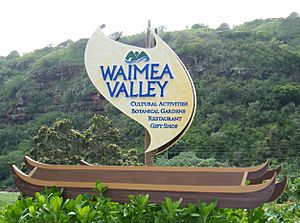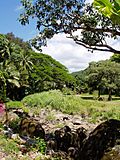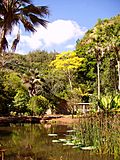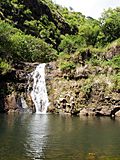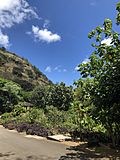Waimea Valley facts for kids
Waimea Valley is a special place on the North Shore of Oahu, Hawaii. It is full of history and culture. This valley was very important in Hawaiian religion. You can still see old stone walls and terraces built long ago by the Hawaiian people.
The valley's rich soil and rainy weather helped ancient Hawaiians grow many crops. They created a thriving farming community. It was one of the best in all of Polynesia. They had clever fish ponds and raised animals. They also grew lots of food like taro, sweet potato, and bananas. Pink taro was especially prized by the Ali`i, who were the Hawaiian leaders. Later, Europeans brought new plants and fruit trees to the valley.
Contents
Waimea Valley's Spiritual History
Waimea Valley was known as a very spiritual place. Ancient Hawaiians held many important religious events here. The largest heiau, or temple, on O’ahu is located in the valley. It stands high above, watching over the area.
The Valley of Priests
In 1092, Waimea Valley was given to the high priests, called the Kahuna Nui. It became home to one of the most respected groups of priests in the islands, the Pa'ao. Even Kamehameha the Great's own priest, Hewahewa, was a descendant of the Pa'ao family.
The Kahuna Nui were very important to Hawaiian society. They were experts in many areas. They knew about farming, healing, and spiritual guidance. They also taught fishing and educated both the Ali’i and the common people. Because of this, Waimea became known as “the valley of the priests.”
After Kamehameha conquered O`ahu, he gave Waimea Valley to Hewa Hewa Nui. This was to make sure the valley kept its sacred importance.
Early European Visitors
The first Europeans to visit O’ahu arrived in 1779. They were the crews of the ships Resolution and Discovery. This happened shortly after the death of Captain Cook.
A Special Nature Park
Today, Waimea Valley is a beautiful nature park with amazing botanical gardens. It used to be called the Waimea Valley Audubon Center or the Waimea Arboretum and Botanical Garden. You can find it at 59-864 Kamehameha Highway in Haleiwa, Oahu, Hawaii.
The park is open every day, except for Christmas and New Year's Day. There is a fee to enter. The City and County of Honolulu managed the garden until 2003. Then, the National Audubon Society took over. In 2008, a non-profit company called Hi'ipaka LLC started managing it. This company was created by the Office of Hawaiian Affairs.
The garden now has 35 different plant collections. It features about 5,000 types of plants from all over the world. It has one of the best collections of Polynesian plants. It also protects many rare Hawaiian plants. You can find plants from places like Lord Howe Island, Guam, Madagascar, and the Seychelles.
Other big collections include hibiscus flowers and plants like araceae, bauhinia, and bromeliads. There are also heliconia, liliaceae, bamboo, begonia, ferns, and tropical fruit trees. For example, you can even see Calamondin citrus trees in the parking lot!
The valley garden is about 0.75 miles (1.21 km) long. At the very end of the valley, there is a small waterfall and a swimming hole.
Fun Activities at Waimea Valley
The waterfall is a popular spot. Sometimes, you can watch people do exciting cliff diving shows there. You can swim in the pool when divers are not performing and when the weather is good. Also, traditional hula dances are performed several times a day.
Images for kids
See also
 In Spanish: Valle Waimea para niños
In Spanish: Valle Waimea para niños


